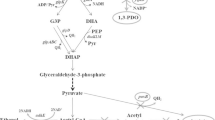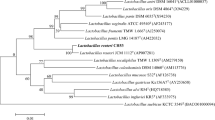Abstract
The environmental and nutritional condition for 1,3-propanediol (1,3-PD) production by the novel recombinant E. coli BP41Y3 expressing fusion protein were first optimized using conventional approach. The optimum environmental conditions were: initial pH at 8.0, incubation at 37 °C without shaking and agitation. Among ten nutrient variables, fumarate, (NH4)2HPO4 and peptone were selected to study on their interaction effect using the response surface methodology. The optimum medium contained modified Riesenberg medium (containing pure glycerol as a sole carbon source) supplemented with 63.65 mM fumarate, 3.80 g/L (NH4)2HPO4 and 1.12 g/L peptone, giving the maximum 1,3-PD production of 2.43 g/L. This was 3.5-fold higher than the original medium (0.7 g/L). Two-phase cultivation system was conducted and the effect of pH control (at 6.5, 7.0 and 8.0) was investigated under anaerobic condition by comparing with the no pH control condition. The cultivation system without pH control (initial pH of 8.0) gave the maximum values of 1.65 g/L 1,3-PD, the 1,3-PD production rate of 0.13 g/L h and the yield of 0.31 mol 1,3-PD/mol crude glycerol. Hence, using crude glycerol as a sole carbon source resulted in 32 % lower 1,3-PD production from this recombinant strain that may be due to the presence of various impurities in the crude glycerol of biodiesel plant. In addition, succinic acid was found to be a major product during fermentation by giving the maximum concentration of 11.92 g/L after 24 h anaerobic cultivation.




Similar content being viewed by others
References
Abbad-Andaloussi S, Amine J, Gerard P, Petitdemange H (1998) Effect of glucose on glycerol metabolism by Clostridium butyricum DSM 5431. J Appl Microbiol 84:515–522
Aghaie E, Pazouki M, Hosseimi MR, Ranjbar M, Ghavipanjeh F (2009) Response surface methodology (RSM) analysis of organic acid production for kaolin beneficiation by Aspergillus niger. Chem Eng J 147:245–251
Barbirato F, Camarasa C, Claret Grivet JP, Bories A (1995) Glycerol fermentation by a new 1,3-propanediol producing microorganism: Enterobacter agglomerans. Appl Microbiol Biotechnol 43:786–793
Barbirato F, Grivet JP, Soucaille P, Bories A (1996) 3-Hydroxypropionaldehyde, an inhibitory metabolite of glycerol fermentation to 1,3-propanediol by enterobacterial species. Appl Environ Microbiol 62:1448–1451
Biebl H, Martin S (1995) Fermentation of glycerol to 1,3-propanediol: use of cosubstrates. Appl Microbiol Biotechnol 44:15–19
Cheek J, Broderick JB (2001) Adenosylmethionine-dependent iron-sulfur enzymes: versatile clusters in a radical new role. J Biol Inorg Chem 6:209–226
Circle SJ, Stone L, Boruff CS (1945) Acrolein determination by means of tryptophan a colorimetric micrometric. Ind Eng Chem Res 17:259–262
Frey PA, Magnusson OT (2003) S-Adenosylmethionine: a wolf in sheep’s clothing, or a rich man’s adenosylcobalamin. Chem Rev 103:2129–2148
Garg SK, Jain A (1995) Fermentative production of 2,3-butanediol: a review. Bioresour Technol 51:103–109
Ghadge SV, Raheman H (2006) Process optimization for biodiesel production from mahua (Madhuca indica) oil using response surface methodology. Bioresour Technol 97:379–384
Laffend LA, Nagarajan V (1997) Bioconversion of a fermentable carbon source to 1,3-propanediol by a single microorganism. US Patents 5,686,276
Lin R, Liu H, Hao J, Cheng K, Liu D (2005) Enhancement of 1,3-propanediol production by Klebsiella pneumoniae with fumarate addition. Biotechnol Lett 27:1755–1759
Liu HL, Chiou YR (2005) Optimal decolorization efficiency of Reactive Red 239 by UV/TiO2 photocatalytic process coupled with response surface methodology. Chem Eng J 112:173–179
Malaoui H, Marczak R (2001) Influence of glucose on glycerol metabolism by wild-type and mutant strains of Clostridium butyricum E5 grown in chemostat culture. Appl Microbiol Biotechnol 55:226–233
Meinander N, Zacchi G, Hahn-Hägerdal B (1996) A heterologous reductase affects the redox balance of recombinant Saccharomyces cerevisiae. Microbiology 142:165–172
Mongi F, Edward C, William H, Gwang-Hoon G, Almadidy A (2005) Influence of culture parameters on biological hydrogen production by Clostridium saccharoperbutylacetonicum ATCC 27021. World J Microbiol Biotechnol 21:855–862
Oh BR, Seo JW, Choi MH, Kim CH (2008) Optimization of culture conditions for 1,3-propanediol production from crude glycerol by Klebsiella pneumoniae using response surface methodology. Biotechnol Bioproc E 13:666–670
Pirt SJ (1975) Principles of microbe and cell cultivation. Wiley, New York
Qi X, Sun L, Luo Z, Wu J, Meng X, Tang Y, Wei Y, Huang R (2006) Rational design of glycerol dehydratase: swapping the genes encoding the subunits of glycerol dehydratase to improve enzymatic properties. Chin Sci Bull 51:2977–2985
Rasch M (2002) The influence of temperature, salt and pH on the inhibitory effect of reuterin on Escherichia coli. Int J Food Microbiol 72:225–231
Raynaud C, Sarcabal P, Meynial-Salles I, Croux C, Soucaille P (2003) Molecular characterization of the 1,3-propanediol operon of Clostridium butyricum encoding a novel coenzyme B12 independent glycerol dehydrataseand a 1,3-propanediol dehydrogenase. Proc Natl Acad Sci USA 100:5010–5015
Riesenberg D, Schulz V, Knorre WA, Pohl HD, Korz D, Sanders EA et al (1991) High cell density cultivation of Escherichia coli at controlled specific growth rate. J Biotechnol 20:17–28
Rujananon R, Prasertsan P, Phongdara A, Panrat T, Sun J, Rappert S, Zeng AP (2011) Construction of recombinant E. coli expressing fusion protein to produce 1,3-propanediol. Int J Biol Med Sci 1(1):26–32
Sattayasamitsathit S, Prasertsan P, Methacanon P (2011) Statistical optimization for simultaneous production of 1,3-propanediol and 2,3-butanediol using crude glycerol by newly bacterial isolate. Process Biochem 46:608–614
Saxena R, Anand P, Saran S, Isar J (2009) Microbial production of 1,3-propanediol: recent developments and emerging opportunities. Biotechnol Adv 27:895–913
Skraly FA, Lytle BL, Cameron DC (1998) Construction and characterization of a 1,3-propanediol operon. Appl Environ Microbiol 64:98–105
Sun J, Heuvel J, Soucaille P, Qu Y, Zeng AP (2003) Comparative genomic analysis of dha regulon and related genes for anaerobic glycerol metabolism in bacteria. Biotechnol Prog 19:263–272
Tang X, Tan Y, Zhu H, Zhao K, Shen W (2009) Microbial conversion of glycerol to 1,3-propanediol by an engineered strain of Escherichia coli. Appl Environ Microbiol 75:1628–1634
Tong IT, Liao HH, Cameron DC (1991) 1,3-Propanediol production by Escherichia coli expressing genes from the Klebsiella pneumoniae dha regulon. Appl Environ Microbiol 57:3541–3546
Wang F, Qu H, Zhang D, Tian P, Tan T (2007) Production of 1,3-propanediol from glycerol by recombinant E. coli using incompatible plasmids system. Mol Biotechnol 37:112–119
Zeng AP, Biebl H, Schlieker H, Deckwer WD (1993) Pathway analysis of glycerol fermentation by Klebsiella pneumoniae: regulation of reducing equivalent balance and product formation. Enz Microb Technol 15:770–779
Zhang GL, Ma BB, Xu XL, Li C, Wang L (2007) Fast conversion of glycerol to 1,3-propanediol by a new strain of Klebsiella pneumoniae. Biochem Eng J 37:256–260
Zheng ZM, Hu QL, Hao J, Xu F, Guo NN, Sun Y et al (2008) Statistical optimization of culture conditions for 1,3-propanediol by Klebsiella pneumoniae AC15 via central composite design. Bioresour Technol 99:1052–1056
Zhu MM, Lawman PD, Cameron DC (2002) Improving 1,3-propanediol production from glycerol in a metabolically engineered Escherichia coli by reducing accumulation of sn-Glycerol-3-phosphate. Biotechnol Prog 18:694–699
Zhuge B, Zhang C, Fang H, Zhuge J, Permaul K (2010) Expression of 1,3-propanediol oxidoreductase and its isoenzyme in Klebsiella pneumoniae for bioconversion of glycerol into 1,3-propanediol. Appl Microbiol Biot 87:2177–2184
Zinatizadeh AAL, Mohamed AR, Najafpour GD, Isa MH, Nasrollahzadeh H (2006) Kinetic evaluation of high rate POME digestion in an UASFF bioreactor. Process Biochem 41:1038–1046
Acknowledgments
The authors would like to thank the Royal Golden Jubilee (RGJ) Ph.D Program of Thailand Research fund (TRF), Graduate School and Faculty of Agro-Industry, Prince of Songkla University and the Annual Government Budget, Thailand for the financial support of this work.
Author information
Authors and Affiliations
Corresponding author
Rights and permissions
About this article
Cite this article
Rujananon, R., Prasertsan, P. & Phongdara, A. Biosynthesis of 1,3-propanediol from recombinant E. coli by optimization process using pure and crude glycerol as a sole carbon source under two-phase fermentation system. World J Microbiol Biotechnol 30, 1359–1368 (2014). https://doi.org/10.1007/s11274-013-1556-1
Received:
Accepted:
Published:
Issue Date:
DOI: https://doi.org/10.1007/s11274-013-1556-1




